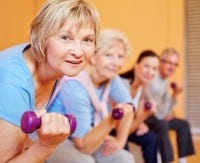Pulmonary rehabilitation: no benefit at one year, even with extended Rx? (Review)

Pulmonary Rehabilitation: No Benefit After 12 Months
Light, Infrequent Workouts Don't Sustain Fitness Gains
Pulmonary rehabilitation ("pulmonary rehab") is a dressed-up name for what are essentially supervised exercise programs for people living with chronic lung disease. Although pulmonary rehab programs often include multidimensional support (nutrition, education, breathing exercises and psychological counseling), it's the exercise that produces the most important benefits of pulmonary rehabilitation. And those benefits are real: pulmonary rehabilitation can reduce shortness of breath, anxiety and depression and improve quality of life, and result in less use of health care resources. Pulmonary rehabilitation has not yet been shown to extend life in people with chronic lung disease, but advocates point out that the available studies have been underpowered either to prove or rule out a survival benefit. Most pulmonary rehabilitation programs have a formal component that lasts 6 to 12 weeks. After that, people are on their own to either continue their exercise program on their own, or not. But there's the rub: most do not continue, and in the absence of sustained effort, the major benefits from pulmonary rehabilitation have been shown to disappear within a year in most people. (Limited evidence suggests that quality-of-life improvements may last in the absence of continued exercise, maybe as a result of improved coping mechanisms.) Some pulmonary rehabilitation services have responded by offering extended supervised programs that continue for months after the formal component of pulmonary rehab ends. Disappointingly, [spoiler alert!] according to a systematic review and meta-analysis in Chest by Marla Beauchamp et al, these extended (but not-very-intense) pulmonary rehab programs don't seem to result in lasting benefits, either.
What They Did
Authors meta-analyzed 7 randomized controlled trials (n=619) in which people just completing pulmonary rehabilitation were randomized to either get continued supervised exercise or usual care. These add-on exercise programs varied from 9 to 15 months after pulmonary rehab. Most participants were elderly (~67 years old) with moderate to severe COPD. All programs included aerobic exercise (walking or cycling); most programs were hospital-based, and led by a physiotherapist. In all but one, sessions were fewer than three per week (usually one per week or even one per month). Because of heterogeneity and people dropping out of the studies, only 385 participants were available for analysis at the 12 month point, reducing power.
What They Found
Participants had a sustained improvement in exercise capacity at 6 months into their extended pulmonary rehabilitation exercise programs. However, at 12 months, there were no significant differences between groups in pooled data from 5 of the trials. In the trial with the longest and most intense exercise after completion of pulmonary rehab (3 times a week for 15 months), exercisers saw a 35 meter improvement in 6-minute walk distance compared to the usual care group (clinically and statistically significant, but only a 6% difference). There were no differences detected between groups in health-related quality of life at 6 or 12 months, using the CRQ and SGRQ scales. Authors warn, "Our results should be interpreted with caution given the heterogeneity in interventions, follow-up intervals, and outcome measures."
What It Means
Pulmonary rehabilitation has been shown to improve exercise capacity and quality of life in the short term, but common sense (and now this meta-analysis) tell us those benefits can't last without sustained effort. Given the relatively low-key approach taken by these programs (often only one day a week of exercise, targeting a 3-4 on the 10-point Borg Dyspnea Scale, compared to 3 times weekly for most pulmonary rehab programs), it's not surprising that participants didn't retain their gains from pulmonary rehab. Supporting this idea, those who exercised more intensely -- 3 times weekly for more than a year after completing pulmonary rehab -- did keep a slight edge over those who stopped. Does this mean exercise is useless? Of course not. These studies weren't powered to measure outcomes like frequency of COPD exacerbations or risk of death from cardiovascular disease. Also, dyspnea and quality of life questionnaires don't fully capture and quantify the experience of life with COPD. Because of "hedonic adaptation," QOL questionnaires can fail to identify real differences between patient groups. In other words, exercise may well help people with chronic lung disease feel better and live longer, in important ways not measured by these studies. One prospective study showed that physical activity level was the single most important factor predicting survival in people with COPD -- more predictive than FEV1, BODE index, or cardiovascular biomarkers like BNP. What separated the more active survivors (0% mortality at 4 years) from the least active group (31% 4-year mortality) was ~1,600 steps a day -- about a mile. This was not a controlled study (so it was inherently biased), but it still makes me want to go for a walk. As a group, people with COPD are very inactive, performing only 6 minutes a day of moderate-to-vigorous activity on average. Encouraging patients to increase that number can be frustrating, and this meta-analysis doesn't help the cause. The idea that every little bit of extra exercise helps may always be an article of faith, but this study doesn't make me lose mine. Marla K. Beauchamp et al. Systematic Review of Supervised Exercise Programs After Pulmonary Rehabilitation in Individuals With COPD. Chest. 2013;144(4):1124-1133. Pulmonary Rehabilitation: Joint ACCP/AACVPR Evidence-Based Clinical Practice Guidelines. Chest. 2007;131(5_suppl):4S-42S. Medscape: "New Guidelines Highlight Benefits of Pulmonary Rehabilitation".


